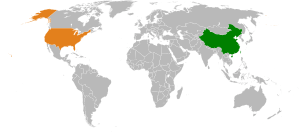Group of Two
The Group of Two (G-2 or G2) is a proposed informal special relationship between the People's Republic of China and the United States of America. Originally initiated in 2005 by C. Fred Bergsten as primarily an economic relationship, it began to gain wider currency and scope from foreign policy experts as a term recognizing the centrality of the Sino-American relations near the beginning of the Obama Administration. Prominent advocates include former National Security Advisor Zbigniew Brzezinski, historian Niall Ferguson, former World Bank President Robert Zoellick and former chief economist Justin Yifu Lin.
|
|

As two of the most influential and powerful countries in the world, there have been increasingly strong suggestions within American political circles of creating a G-2 relationship where the United States and China would work out solutions to global problems together, and to prevent another cold war.[1]
History
The concept of a G-2 was first raised by noted economist C. Fred Bergsten in 2005.[2] In 2009, Bergsten made the following arguments for such a relationship:
- China will shortly pass Japan to become the world's second largest economy behind the United States;
- the two together accounted for almost one half of all global growth during the four-year boom prior to the crisis;
- they are the two largest economies;
- they are the two largest trading nations;
- they are the two largest polluters;
- they are on opposite ends of the world's largest trade and financial imbalance: the United States is the largest deficit and debtor country while China is the largest surplus country and holder of dollar reserves; and
- they are the leaders of the two groups, the high-income industrialized countries and the emerging markets/developing nations, that each now account for about one half of global output.[3]
Zbigniew Brzezinski had been a vocal advocate for the concept. He publicly advanced the notion in Beijing in January 2009 as the two countries celebrated the 30th anniversary of establishing formal diplomatic ties.[4] He views the informal G-2 as helpful in finding solutions to the global financial crisis, climate change (see Politics of global warming), North Korea's nuclear program, Iran's nuclear program, the India–Pakistan tensions, the Israeli–Palestinian conflict, United Nations peacekeeping, nuclear proliferation, and nuclear disarmament. He called the principle of "harmony" a "mission worthy of the two countries with the most extraordinary potential for shaping our collective future".[5][6]
Historian Niall Ferguson has also advocated the G-2 concept. He coined the term Chimerica to describe the symbiotic nature of the U.S.-China economic relationship.
Robert Zoellick, former president of the World Bank, and Justin Yifu Lin, the Bank's former chief economist and senior vice president, have stated that the G-2 is crucial for economic recovery and that the U.S. and China must work together. They state that "without a strong G-2, the G-20 will disappoint".[7]
While widely discussed, the concept of a G-2 has not been fully defined. According to Brzezinski, G-2 described the current realities, while for former British Foreign Secretary David Miliband, a G-2 could emerge in the foreseeable future.[4] Miliband proposes EU integration as a means to create a potential G-3 that consists of the United States, China and the European Union.
Former President Barack Obama and former United States Secretary of State Hillary Clinton have been very supportive of good relations between the two countries and more cooperation on more issues more often. Former Secretary of State Henry Kissinger has stated that U.S.–China relationship to be "taken to a new level". Some experts have disagreed with the effectiveness of a G-2.[8] However, Clinton has said that there is no G-2.[9]
The G-2 concept has been often evoked in international media during major bilateral meetings such as the Strategic and Economic Dialogue and state visits as well as during global summits like the G-20 meetings and the Copenhagen Summit.
See also
References
- Boston Study Group on Middle East Peace (2009-05-14). "Foreign Policy Association: Resource Library: Viewpoints: Moving the G-2 Forward". Fpa.org. Retrieved 2010-06-27.
- "Two's Company". Foreign Affairs. 2009-09-01. Retrieved 2010-06-27.
- "Testimony: The United States–China Economic Relationship and the Strategic and Economic Dialogue". Iie.com. Archived from the original on 2010-06-24. Retrieved 2010-06-27.
- "Asia Times Online :: China News, China Business News, Taiwan and Hong Kong News and Business". Atimes.com. 2009-05-29. Retrieved 2010-06-27.
- Wong, Edward (2009-01-02). "Former Carter adviser calls for a 'G-2' between U.S. and China". The New York Times.
- "The Group of Two that could change the world". Financial Times. 2009-01-13. Retrieved 2010-06-27.
- Zoellick, Robert B.; Lin, Justin Yifu (2009-03-06). "Recovery: A Job for China and the U.S." The Washington Post. Retrieved 2010-06-27.
- "The G-2 Mirage". Foreign Affairs. 2009-05-01. Retrieved 2010-06-27.
- Landler, Mark (14 January 2011). "U.S. Is Not Trying to Contain China, Clinton Says". The New York Times. Retrieved 15 June 2018.
.svg.png)